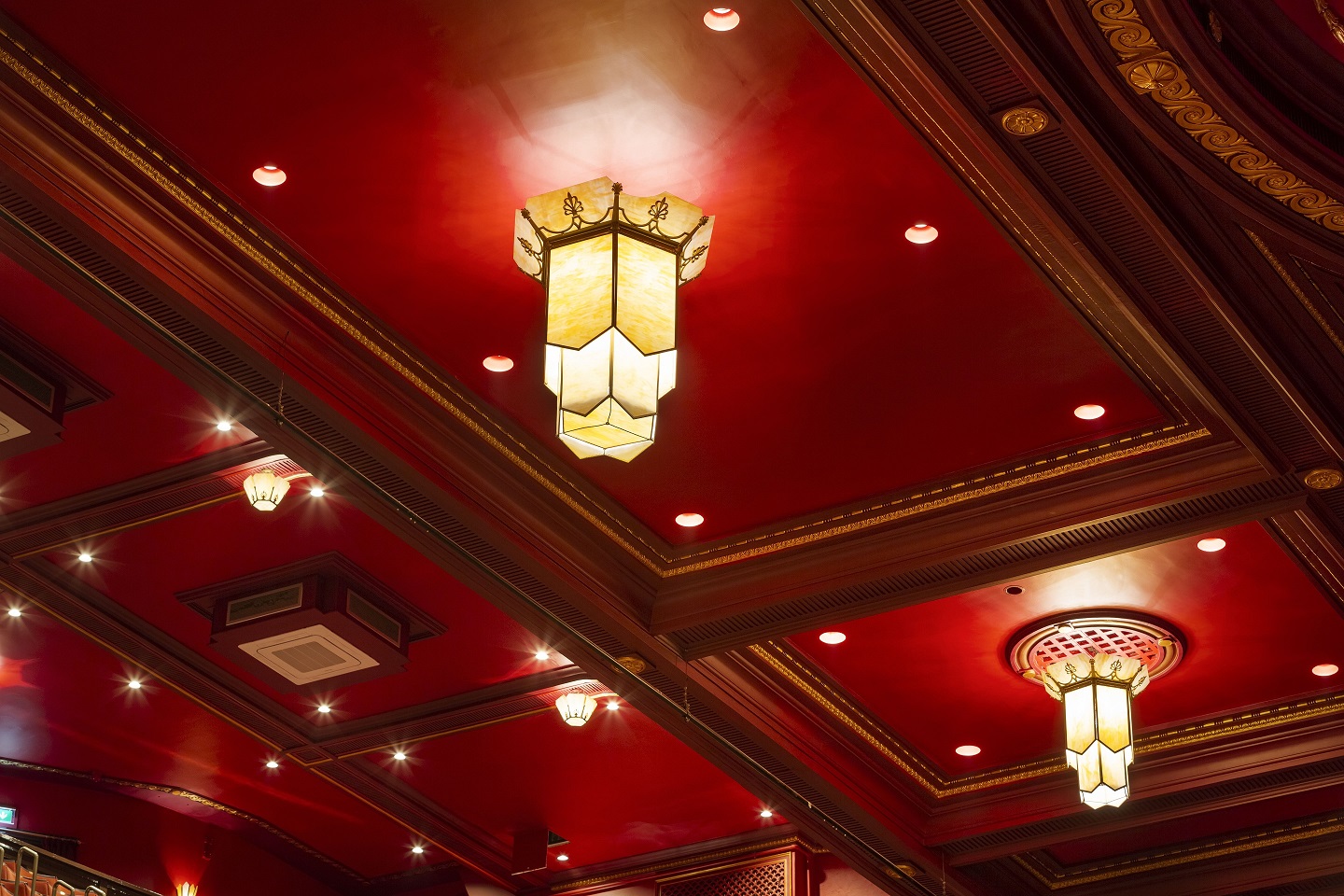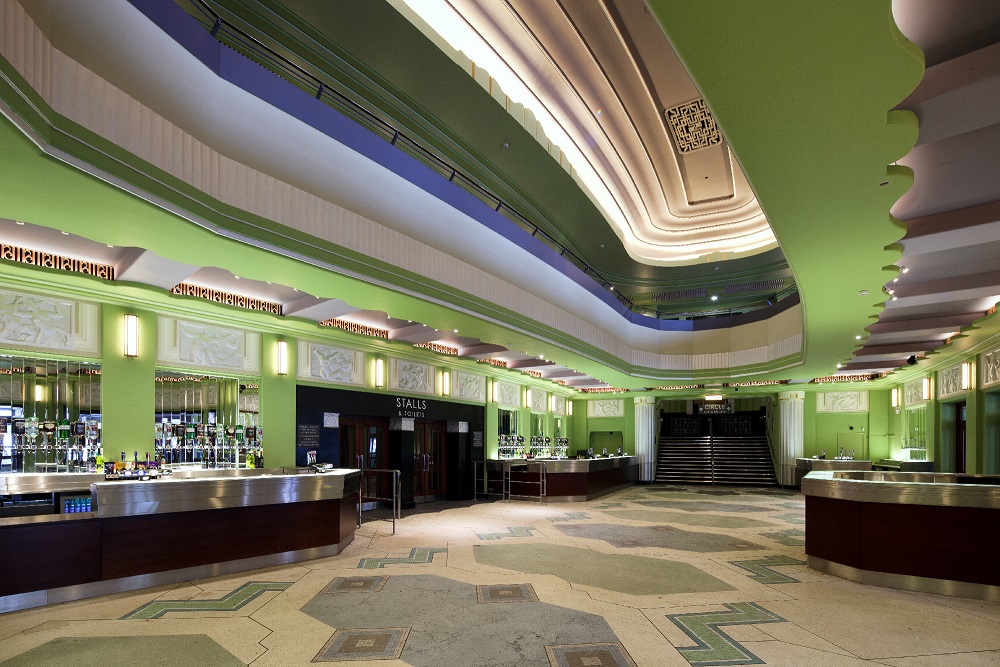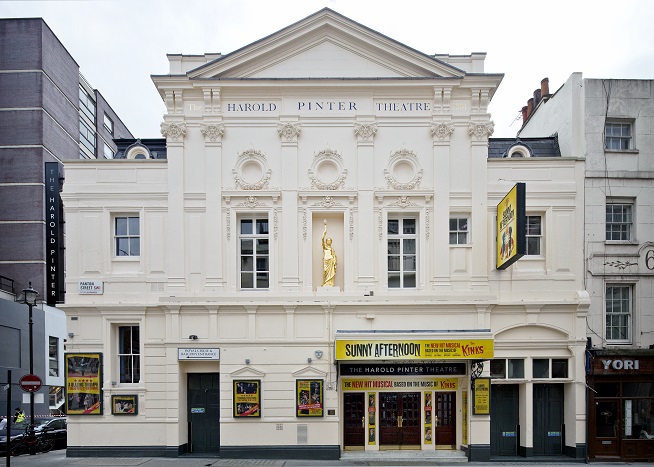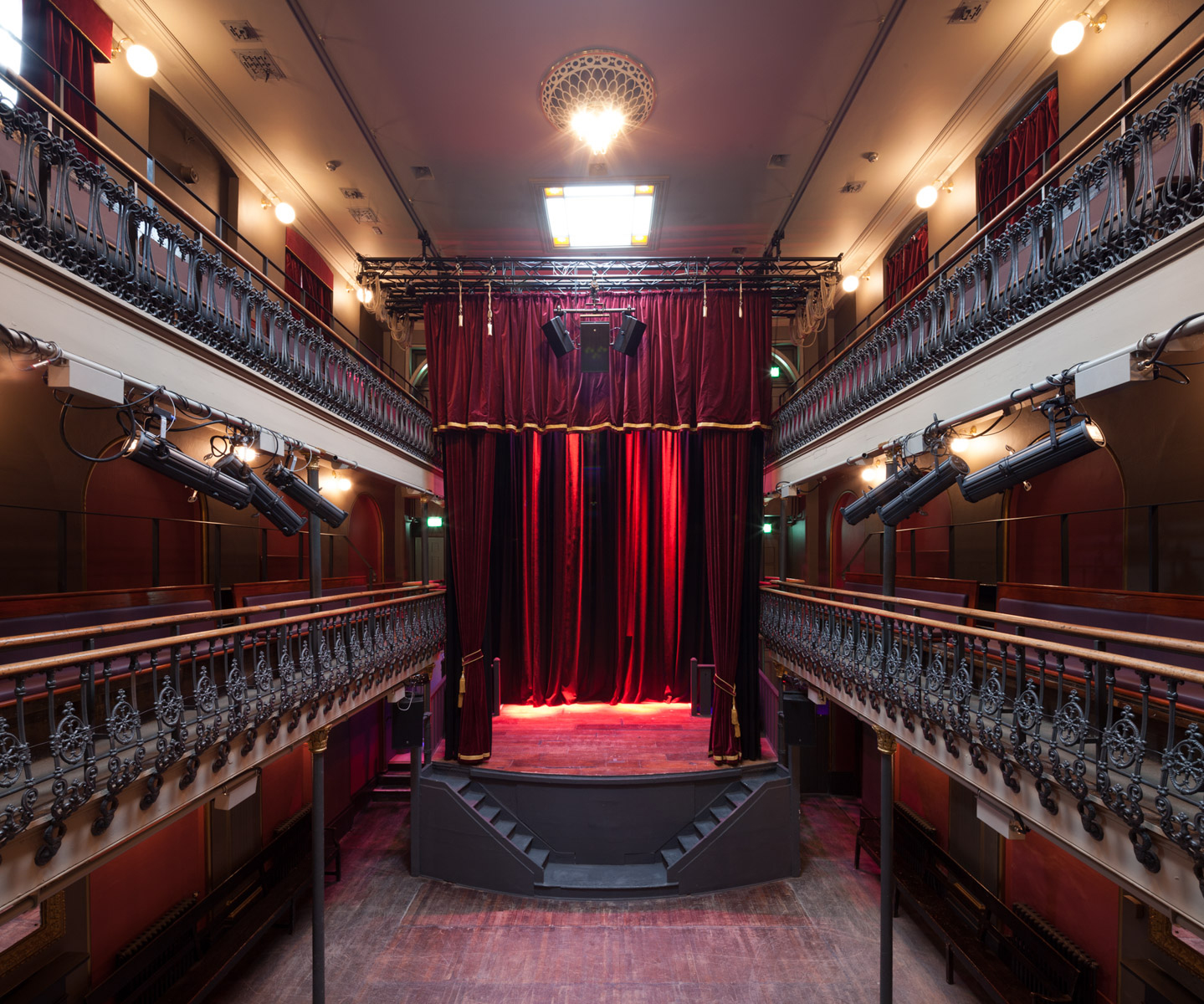How Green is Your Theatre?
Environmental improvements to historic performance venues
Edmund Wilson

The Art Deco (c1930) auditorium of the Trafalgar Theatre, London, which has recently reopened with a more efficient ventilation system and low energy LED lighting (Photo: Tom Lee)
The demolition of old buildings has, for a long time, been justified by the idea that meaningful improvement means replacement with something that is new and more efficient. In the fact of this argument, historic buildings have relied on legislation and public support to justify their existence, rather than their environmental credentials.
However, recent research has shown that the majority of a new building’s carbon footprint is not carbon consumed in its operation by heating and lighting, but in the embodied carbon used in its construction. With only a small proportion of the building stock being replaced every year, the buildings with which we will face the crucial years of the climate crisis are the buildings we have now.
These striking facts have helped shift thinking from replacement towards the necessity of improving the carbon running costs of the existing building stock. Urgent action on the climate crisis does not mean a rush to construct new buildings.
Given the scale and complexity of upgrading nearly every aspect of existing buildings, there is a danger that the sheer size of the task could translate into complacency or inaction. Old buildings are inefficient to run, consuming huge amounts of fuel to provide levels of comfort they were never designed for. The problems of heating, cooling and ventilating historic theatre buildings to modern standards are only magnified by the size of the spaces involved. Their size, combined with current expectations of comfort, make these buildings some of the most expensive and energy intensive to run.
How the environmental efficiency of existing performance venues might be improved was the subject of the Theatres Trust Conference in 2021, Making Theatre Sustainable. The event saw the launch of the Theatre Green Book, an invaluable guide for theatre owners and operators on how to improve the environmental performance of their venue. Edited by Paddy Dillon, one of the innovations of the Theatre Green Book is the link it provides to an online assessment tool developed by engineers Buro Happold. This tool allows theatre operators to input data from their building and produce a quick assessment of where energy is being spent and which improvements will give the most benefit.
A key point made at the conference by historic theatre specialist David Wilmore was that you must first understand your building. Studying the original building design often reveals an innate logic as to how the space should be heated and ventilated, that is then lost over time through addition and adaptation. For example, rooflights may have been sealed, ducts blocked and wholescale changes made to heating and lighting.
A thorough understanding of how a building was originally conceived provides a solid foundation for improvements. Another clear point from the conference is that although the environmental impact of a historic performance venue is multifaceted, there are clear principles that apply as much to the environmental improvements of historic buildings as to the environmental design of new ones. These include:
- Using clean energy sources
- Using efficient fittings and controls
- Maximising insulation and air tightness to prevent heat loss
- Minimising embodied carbon in new materials
- Minimising energy used for ventilation and cooling
The real life examples that follow illustrate the type of improvements that can improve the environmental performance of a historic venue.
Lighting

Original fittings refurbished with new LED light sources at the Mayflower Theatre, Southampton (Photo: Tom Lee)
Part of the reason Georgian and Victorian theatres burnt down so often was that the lighting was originally provided by an open flame, first by candlelight and then gaslight. It would take little for flammable scenery or curtains to catch light and fire to spread. Gaslight was replaced by electric tungsten lighting early in the 20th century, giving a safer and suitably warm light but still using a lot of energy.
Later in the 20th century newly available fluorescent and early LED lighting was very cold in colour and was avoided by theatres that needed to keep an atmospheric setting. Only recently has it been possible to produce LED lights that have a warm colour temperature, are low in cost and, crucially for theatre house lighting, can be dimmed seamlessly down to very low levels.
Aside from efficiency, the advantages of LED lighting include producing far less heat, reducing cooling loads and being so small they can produce dramatic lighting effects in an interior by hiding light sources within and behind decorative detail. In this way dramatic or coloured interiors can be created while retaining an authentic colour scheme. Lighting designers Jim Morse and Hoare Lee have lit historic interiors such as the Apollo Victoria and Hammersmith Apollo for dramatic effect, while retaining the historic decorative scheme.

A low-energy, low-heat LED lighting scheme at the Hammersmith Eventim Apollo (Photo Tom Cronin
Intelligent controls
Another easy improvement for any historic venue is to control energy use during periods of low occupation. In the past many venues would heat a vast space for just a few technical crew, many hours before the public arrived. At its simplest, improvements can be clearly communicated instructions on how to minimise waste like this. At a more technical level, managing heating, ventilation and lighting can be operated automatically using motion sensors, timers and air quality monitors that turn off or turn down services when an area is not fully occupied.
The use of these sensors is normal practice in new development, but they work equally well when installed in historic buildings. At a more complex level, services can be programmed using a building management system (BMS) and managed using software. In practice, a BMS can be complex and there is a risk of a building owner being unable to fully operate the software and reverting to on/off switches. It is therefore important that the system is designed to suit the operator’s skill level.
Insulation

The Harold Pinter Theatre in London’s West End: like most Victorian theatres, the use of complex architectural forms and rich details, inside and out, make much of the building’s external envelope extremely difficult to insulate. (Photo: Tom Cronin)
In contrast, one of the most difficult issues faced when upgrading is the improvement of levels of insulation. Typically, historic theatres and cinemas have a basic structure that is poorly insulated, including masonry walls with no cavity and single glazed windows.
There are good alternatives to the steel-framed ‘Crittall’ type of window widely used in the early 20th century. New steel windows with double-glazing units and thermally broken frames can match existing fenestration patterns and may not greatly alter the appearance of the building. Secondary glazing can also be a good solution, particularly if the building is listed, as it retains original features and the appearance of a facade, while improving thermal performance and acoustic separation within.
The improvement of wall insulation is a more difficult challenge. Although it is possible to add insulation to the inside of a wall, there is a limit to how much can be added before the inside face of the masonry wall becomes too cold and attracts condensation. Adding wall insulation to the outside of walls is not an easy solution either given this means change to the external appearance.
Architectural practice Foster Wilson Size is currently working on a project to refurbish a performance venue dating from the 1930s to achieve Passivhaus standards. The only viable way to do so is by introducing external wall insulation, which is to be clad in brick slips that mimic the existing brickwork and replicate the current appearance, albeit with thicker walls. In most cases this strategy might have more relevance in improving the insulation of the side walls of a theatre, which can be very utilitarian in comparison to the front façade. Leaving a front façade intact_ while improving the insulation of side walls can still bring major benefits to overcoming heat loss.
Ventilation and cooling
Ventilation has understandably received a lot of attention recently. It is clearly very important to ensure that an audience receives plenty of fresh air, but the ventilation and cooling systems are often the biggest consumers of power. It is possible to achieve natural ventilation and cooling in the design of a new auditorium.
For the new performing arts space at Cheltenham Ladies College, Foster Wilson Size used an under-croft below the new auditoria to moderate the temperature of air which is brought in below the seating close to the audience, before being released as warmer air at the top of the auditoria by a chimney stack effect.
Although it is very difficult to retrofit an existing auditorium designed exclusively for mechanical ventilation, older theatres of the Victorian period that predate the widespread use of this method were originally designed with ingenious methods of ventilation that can offer clues for current improvement. Victorians understood the basic laws of thermodynamics and used the release of hot air to draw fresh air in at the base of an auditoria.
One of the most popular ventilation methods for 19th century theatres was the use of Sunburners, a ventilation and lighting installation powered by gas jets, providing both light and the heat source for a chimney stack effect stale air extract. During the restoration of Hoxton Hall, a beautiful music hall of the 1860s, the ventilation system was able to use the position of the original Sunburners as these were already located in the best place to expel hot air. Generally, the biggest energy saving in ventilation for historic auditoria is the use of heat exchange units that use the warmth of the air extracted from the space to heat incoming air from outside so that not all the energy in the heated air is lost.

Hoxton Hall, an 1860s music hall in London which is now ventilated using the ducts from the original sunburners (Photo: Peter Guenzel)
Heating
Large auditoria today are typically heated by burning vast quantities of gas, which is clearly incompatible with a move towards zero carbon emissions. Although hydrogen boilers may be an option in the long term, in the short term often the only viable greener energy option is to replace gas boilers with electric heat pumps. Heat pumps work like a fridge in reverse, extracting warmth from air outside or in the ground to transfer to the interior.
In order to meet contemporary expectations of comfort, historic theatres are often heated or cooled to a uniform temperature throughout the year. When first built, much wider ranges of temperature were expected by theatre going audiences. The Globe theatre is by its very nature green, located in a city centre site with very few members of the audience arriving by car, built from timber and requiring no ventilation or heating.
Clearly this example has limited relevance for indoor theatres, but should all venues aim for an ambient temperature of 21°c regardless of whether it is winter or summer? Should a theatre consider closing in mid-summer when audience numbers are lower rather than install a new cooling system?
Design issues
Theatres and large venues can be good places for producing green energy. Large auditoria have roofs often not visible from the street that can be ideal candidates for the location of solar cells, which produce a significant proportion of the energy consumed in a building’s services. This technology is as appropriate for a historic building as it is for a new building.
Given that the embodied energy of construction can often be the largest carbon impact of any new work, it is very important to assess the carbon footprint of materials and processes to be used in any renovation. The benefit of using grown materials such as timber is not only that they require lower amounts of energy to prepare, but they provide a way to store carbon extracted from the atmosphere. To put it another way; building with carbon is better than burning it.
Clearly it is not always possible to repair or alter historic masonry structures using timber, but care is still needed in sourcing local masonry products so that the energy used in their making is not added to by the energy used in their transportation.
First steps
In the face of such a holistic and detailed problem as climate change there is clearly a danger of inaction, or progress held back by poor understanding of all the issues at play. But in reality there is nothing wrong in starting with easy improvements. Easy wins are by their nature cost effective; it is often the more difficult to achieve solutions that are the most expensive and marginal in benefit.
Managers and technicians of historic theatres are well placed to make decisions on where to begin and will know where waste and inefficiencies lie because they know their buildings intimately. Sensible improvements can be made with a combination of planning and pragmatism.
An intelligent renovation of a historic theatre will start by understanding the design of the building as originally conceived and whether existing systems can be used or adapted, rather than treating an auditorium as a sealed box to be serviced with new equipment. Every historic theatre should undertake careful planning, with suitably experienced consultants, so that there is an overall plan to work to, but the staff who best know the building will often be best placed to make change, starting with the most obvious gains.
The climate emergency clearly affects all areas of life in complex ways that are difficult to assess, but given the energy emitted by historic buildings is such a large and clear component of current carbon emissions, inaction is not a good option.



